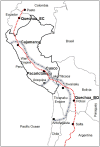Genetic ancestry of families of putative Inka descent
- PMID: 29502256
- PMCID: PMC6061041
- DOI: 10.1007/s00438-018-1427-4
Genetic ancestry of families of putative Inka descent
Abstract
This study focuses on the descendants of the royal Inka family. The Inkas ruled Tawantinsuyu, the largest pre-Columbian empire in South America, which extended from southern Colombia to central Chile. The origin of the royal Inkas is currently unknown. While the mummies of the Inka rulers could have been informative, most were destroyed by Spaniards and the few remaining disappeared without a trace. Moreover, no genetic studies have been conducted on present-day descendants of the Inka rulers. In the present study, we analysed uniparental DNA markers in 18 individuals predominantly from the districts of San Sebastian and San Jerónimo in Cusco (Peru), who belong to 12 families of putative patrilineal descent of Inka rulers, according to documented registries. We used single-nucleotide polymorphisms and short tandem repeat (STR) markers of the Y chromosome (Y-STRs), as well as mitochondrial DNA D-loop sequences, to investigate the paternal and maternal descent of the 18 alleged Inka descendants. Two Q-M3* Y-STR clusters descending from different male founders were identified. The first cluster, named AWKI-1, was associated with five families (eight individuals). By contrast, the second cluster, named AWKI-2, was represented by a single individual; AWKI-2 was part of the Q-Z19483 sub-lineage that was likely associated with a recent male expansion in the Andes, which probably occurred during the Late Intermediate Period (1000-1450 AD), overlapping the Inka period. Concerning the maternal descent, different mtDNA lineages associated with each family were identified, suggesting a high maternal gene flow among Andean populations, probably due to changes in the last 1000 years.
Keywords: Inkas; MtDNA; Panakas; Y chromosome; Y-SNPs; Y-STRs.
Conflict of interest statement
Conflict of interest
The authors declare no conflict of interest.
Ethical approval
All procedures performed in studies were in accordance with the ethical standards under the supervision of the international review board of the Universidad de San Martín de Porres (IRB00003251-FWA0015320) and with the 1964 Helsinki Declaration and its later amendments or comparable ethical standard.
Informed consent
Informed consent was obtained from all individual participants included in the study.
Figures



References
-
- Amado-Gonzales D. El Alférez Real de los Incas, Resistencia, cambios y continuidad de la identidad Inca. En: Elites indígenas en los Andes. Quito: Ediciones Abya-Yala; 2003.
-
- Amado-Gonzales D. Los nietos del Inca Lloque Yupangui: La Panana Haguainin y los Tisoc Sayre Tupa. En: Revista del Archivo Regional del Cusco No 17. Perú: Cusco; 2005.
-
- Amado-Gonzales D. La formación de parroquias y la nobleza incaica en la ciudad del Cuzco. En: El ombligo se pone piercing. Cusco: Centro Guaman Poma de Ayala; 2009.
Publication types
MeSH terms
Grants and funding
LinkOut - more resources
Full Text Sources
Other Literature Sources

